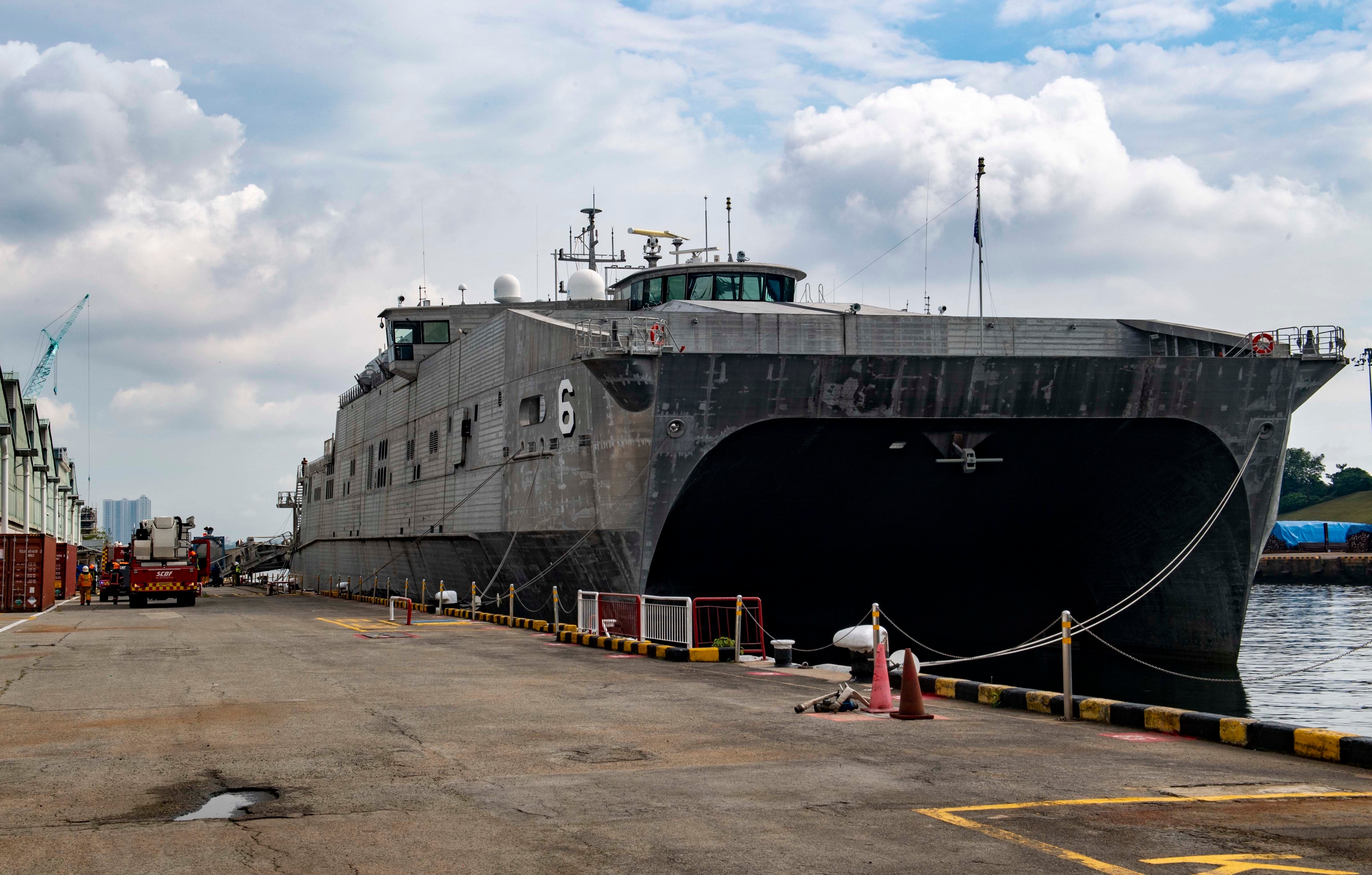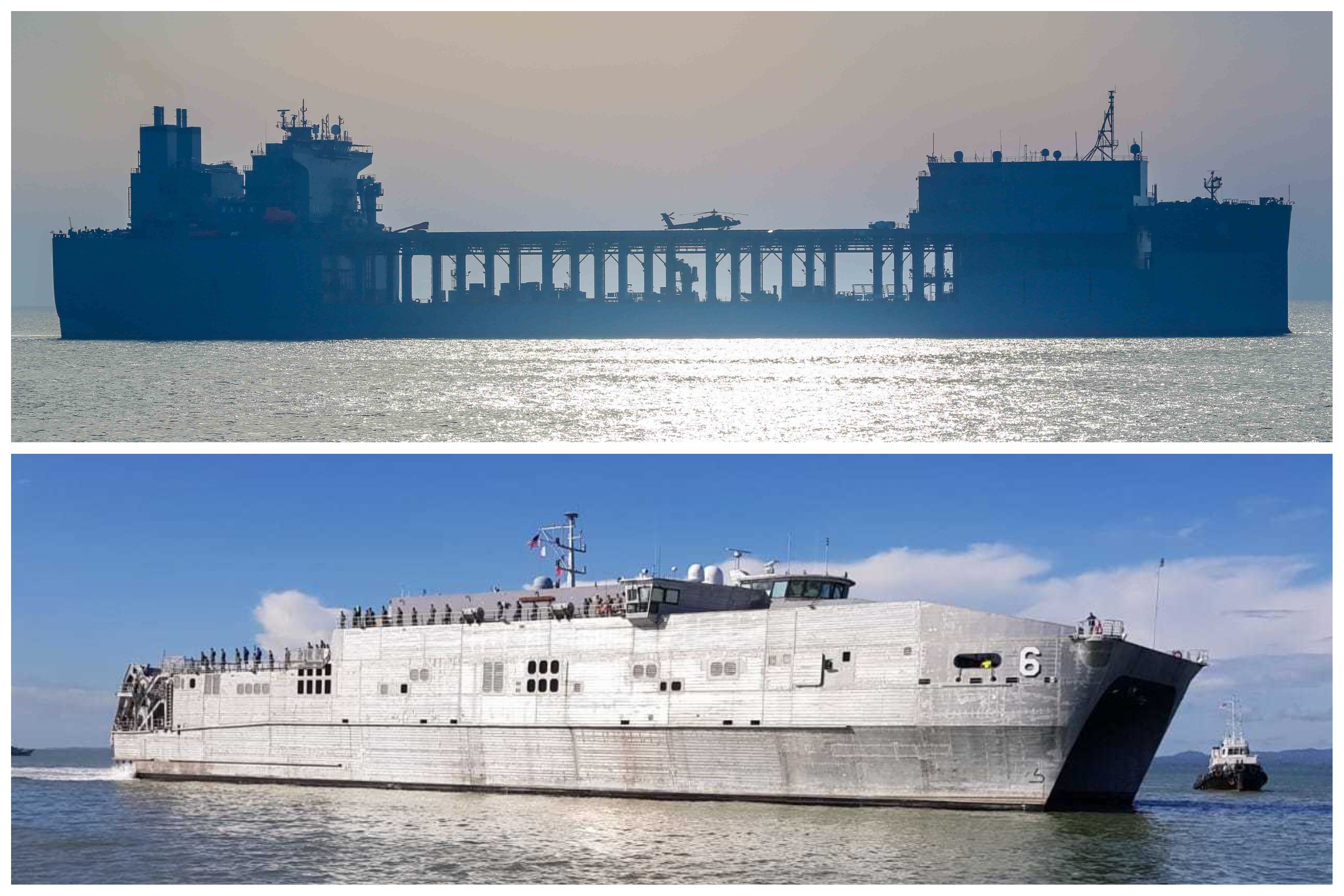By: Mallory Shelbourne
USS Lewis B. Puller (ESB-3), USNS Brunswick (T-EPF-6)
Without a carrier strike group or amphibious readiness group currently operating in the Middle East, the U.S. Navy has dispatched two little-known ship classes to help the State Department evacuate people from Sudan.
Spearhead-class Expeditionary Fast Transport USNS Brunswick (T-EPF-6) moved about 300 people from Port Sudan to Jeddah, Saudi Arabia on Monday. Meanwhile, Lewis B. Puller-class expeditionary sea base USS Lewis B. Puller (ESB-3) is also operating in the Red Sea, standing by to aid in the evacuation mission.
The EPFs, built by Austal USA in Mobile, Ala., and the ESBs, built by General Dynamics NASSCO in San Diego, Calif., have both received attention from the Marine Corps in recent years as an interim solution to move Marines around for its island-hopping strategy while the Navy pursues the Landing Ship Medium. But both classes are now fulfilling missions typically performed by other U.S. Navy assets like amphibious warships at a time when the fleet is balancing operations between the Indo-Pacific, Mediterranean and the Middle East.
While one of the main Marine Corps missions is crisis response and humanitarian aid and disaster relief, service officials in the last year have highlighted the lack of available and ready amphibious warships to deploy and operate across the globe.
Since there are no nearby ARGs that could respond to the situation in Sudan, the Marine Corps’ senior officer told lawmakers last week that he “let down” U.S. Africa Commander Gen. Michael Langley.
“First, we would have gaps during the year when we would not have an at-sea capability for the combatant commander when something happened. We would not be deterring. We would not be in a position to respond,” Gen. David Berger told the House Armed Services Committee when asked what would happen if the Marine Corps has fewer than 31 amphibious warships, the statutory requirement.
“Here, places like Turkey or [the] last couple of weeks in Sudan, I feel like I let down the combatant commander because Gen. Langley needs options. He didn’t have a sea-based option. That’s how we reinforce embassies. That’s how we evacuate them. That’s how we deter,” he added.
“It opens up risks for the combatant commander. We have to have 31 at a minimum. Nothing less.”
Spearhead-class

USNS Brunswick (T-EPF-6) took part in an interagency, international fire drill at Sembawang Wharves, Nov. 2, 2022. US Navy Photo
The EPFs originally began as a joint program with the U.S. Army known as the Joint High Speed Vessel merging the Army’s Theater Support Vessel program and the Department of the Navy’s own effort to move Marines inside a maritime theater. The Navy and Marine Corps experimented with renting high-speed civilian ferries before settling on a final design.
However, by the time shipbuilder Austal USA delivered the first hull – USNS Spearhead (T-EPF-1) – in 2012, the Navy had taken charge of the program.
The aluminum catamarans are operated under Military Sealift Command and crewed by about 40 civilian mariners. Designed as an intra-theater connector, the EPFs can move troops and equipment at high speeds, with the ability to sail at 35 to 40 knots and a low draft capable of operating in almost any port.
They can transport up to 300 fully loaded combat Marines and an M-1 A2 main battle tank. The ships also have a helicopter deck large enough to land MV-22B Osprey tilt-rotor aircraft.
ESBs
The Navy describes Puller as “the first purpose-built expeditionary sea base vessel” that can perform a variety of missions, ranging from small boat operations to anti-piracy.
Originally carrying the USNS designation under Military Sealift Command, in 2017 the Navy commissioned Puller as a warship so it could better support both the numbered fleet and combatant commanders in the Middle East. Then, in 2020, the Navy announced it would commission all ships in the class as warships with the USS designation.
Based on a commercial oil tanker, the U.S. Navy removed the middle of the ship so it could serve as a mission bay and then put a flight deck on the top for the new ESB design. The flight deck has four spots to accommodate both helicopters and tiltrotor aircraft.
The first two hulls in the class were designed to serve as an at-sea transfer point that would allow roll-on/roll-off cargo ships to load military vehicles onto Navy Landing Craft Air Cushion (LCAC) without having to offload the gear at a port. The Navy abandoned the mobile landing platform concept after the first two ships delivered and pivoted to creating a large platform for special operations and mine countermeasure forces.
Following expeditionary transfer docks USNS Montford Point (T-ESD-1) and USNS John Glenn (T-ESD-2), Puller was the first built for the sea base mission.
The idea for the sea bases goes back to the Vietnam and Iran-Iraq wars when barges served as mobile platforms to stage forces without having a footprint ashore.
The Navy now has three ESBs commissioned, with three more under construction.











No comments:
Post a Comment
How did you like the post, leave a comment. I would appreciate hearing from you all. Best wishes from JC's Naval, Maritime and Military News